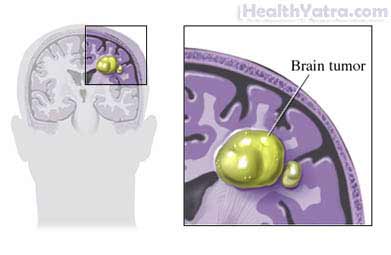সংজ্ঞা
Glioblastoma multiforme (GBM) is the most common glioma (a type of brain cancer). It represents nearly one fourth of all primary brain tumors. This cancer starts in the glial cells, which are cells that help nerve cells work.
This condition can develop spontaneously. Less commonly, it can develop from a lower grade, less malignant (cancerous) মস্তিষ্ক আব. Most cases are located in the cerebral hemisphere, but the cancer can begin in the spinal cord or brain stem.
If you suspect you have this serious condition, contact your doctor immediately. Early treatment leads to a more favorable outcome.

কারণসমূহ
GBM originates from astrocytes, which are a type of glial cell. The factors that cause normal-functioning astrocytes to become cancerous is not well understood.
ঝুঁকির কারণ
These factors increase your chance of developing GBM. Tell your doctor if you have any of these risk factors:
- Sex: male (slightly more common in men that women)
- বয়স: 50 বছরের বেশি বয়সী
- Ethnicity: Caucasians, Latinos, Asians
- Having a low-grade astrocytoma (brain tumor), which occasionally develops into a higher-grade tumor
- Having one of the following genetic disorders is associated with an increased incidence of gliomas
- নিউরোফাইব্রোমাটোসিস
- কন্দযুক্ত স্ক্লেরোসিস
- Von Hippel-Lindau disease
- Li-Fraumeni syndrome
- Turcot’s syndrome
- Radiotherapy (association between high-dose ionizing radiation and astrocytoma)
There is inconsistent evidence that electromagnetic radiation and cell phone use are associated with this condition.
লক্ষণ
উপসর্গ অন্তর্ভুক্ত:
- New onset headaches—more than 30% of patients
- New onset seizures—20% to 30% patients
- Progressive cognitive dysfunction—depends on the location of the tumor; problems with vision, language, motor function, or sensation may occur
- ব্যক্তিত্বের পরিবর্তন হয়
- Behavioral changes, development of inappropriate behaviors
- স্মৃতিশক্তি হ্রাস
রোগ নির্ণয়
After taking a complete history of your symptoms and completing a physical exam, your doctor may also use the following tests:
- CT scan —a type of x-ray that uses a computer to make pictures of structures inside the brain
- MRI scan —a test that uses magnetic waves to make pictures of structures inside the brain
- Functional MRI (fMRI)—a test that gathers information on blood flow within tumors, gives more information about the tumor and the function of surrounding normal brain tissue
- MRS scan—a test which measures metabolism (of the affected area) in the brain
- ইলেক্ট্রোয়েন্সফালোগ্রাম (EEG) - একটি পরীক্ষা যা মস্তিষ্কের মাধ্যমে বৈদ্যুতিক স্রোত পরিমাপ করে মস্তিষ্কের কার্যকলাপ রেকর্ড করে
- Brain biopsy —removal of a sample of brain tissue to test for abnormalities in the brain
- Spinal tap —removal of a small amount of cerebrospinal fluid to check for abnormalities in the brain
- Positron emission tomography (PET) scan and single photon emission tomography SPECT scan—produces images that show the amount of functional activity in the living tissue being studied
চিকিৎসা
Surgery is often done to confirm diagnosis and relieve headache, but doctors cannot completely remove the cancer. Other types of treatment may include:
- Radiation treatment is used to further decrease the size of the tumor, usually by about 25% and may be most helpful in improving survival in older patients.
- Chemotherapy also increases survival time and quality of life.
- Steroids to suppress swelling, antiseizure medication to suppress seizures, and pain medications are also used.
Currently, researchers are studying new treatments. These include:
- ইমিউনোথেরাপি
- Anti-angiogenesis (to stop tumors from making new blood cells)
- Molecular therapy
- Gene therapy
- Genetic analysis of the tumor—This is becoming an important tool in determining which therapies are best suited for a given individual. More research needs to be done in these areas.
Unfortunately, overall prognosis is poor. Even with aggressive treatment, few patients survive more than five years after diagnosis. However, there is evidence that medical and surgical intervention can increase life expectancy and improve quality of life.
A multi-disciplinary approach is important for you and your family. This approach may involve:
- Support group
- Psychotherapy and psychiatry
- Pain management
- Hospice care
প্রতিরোধ
As the causes of GBM are unknown, there are no preventive measures.
